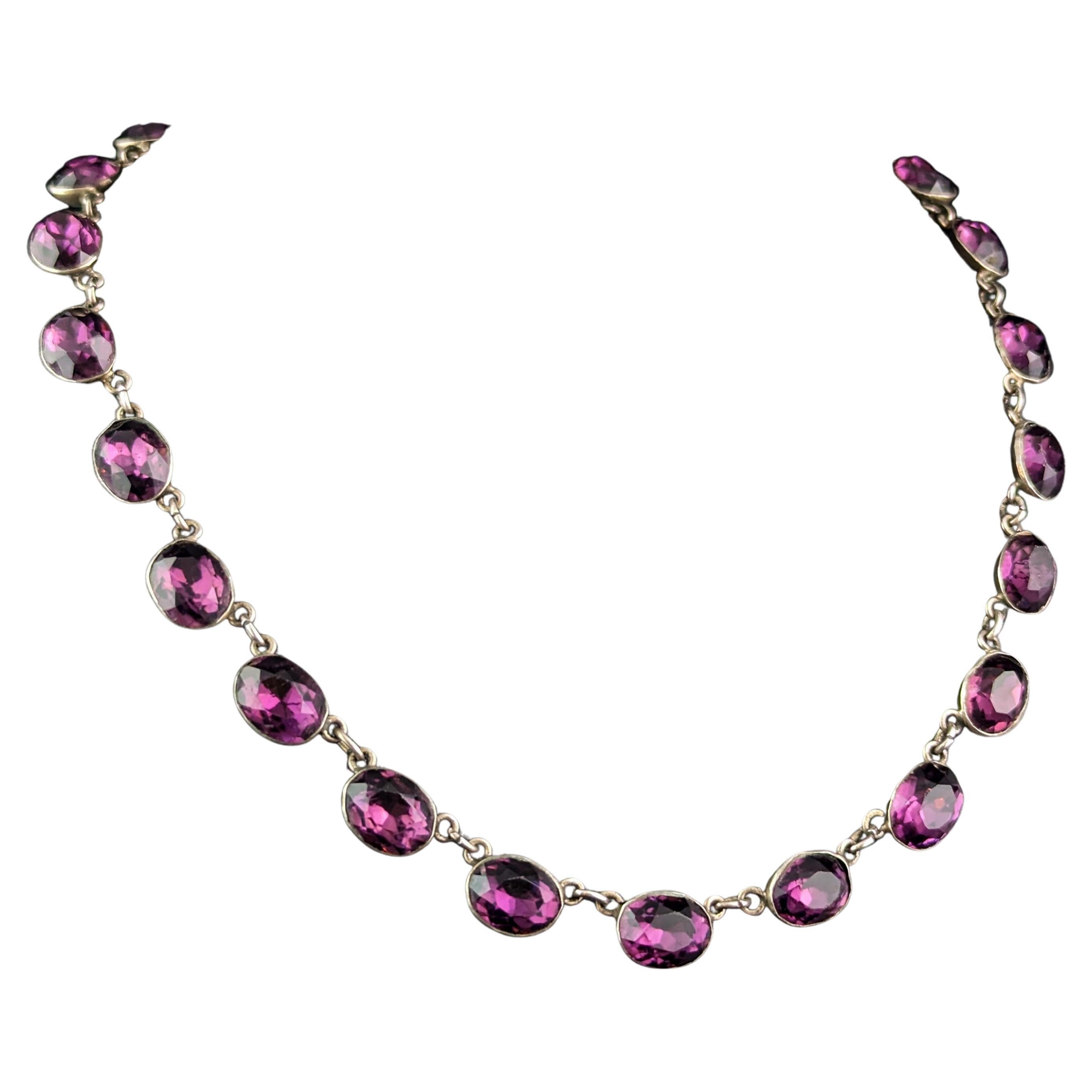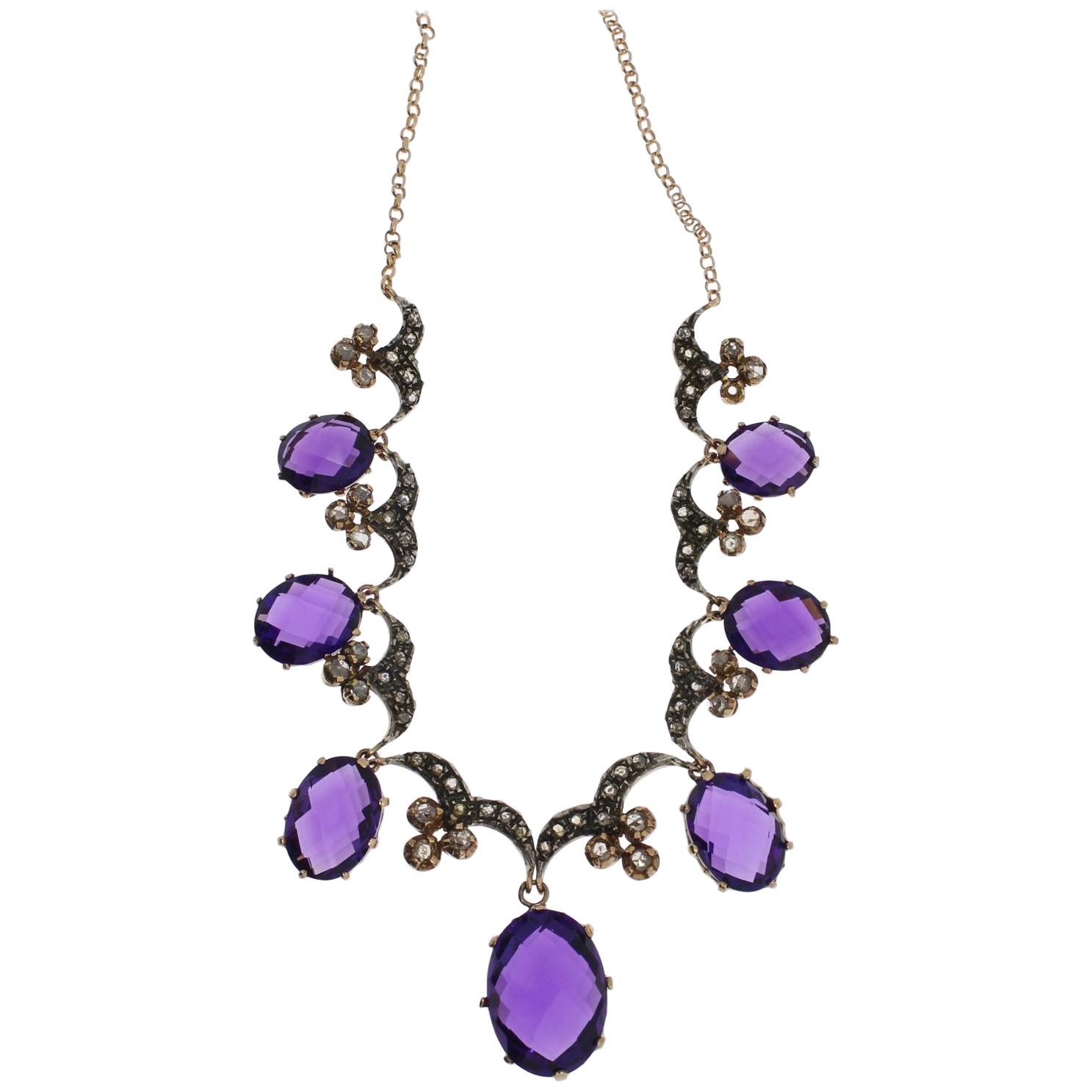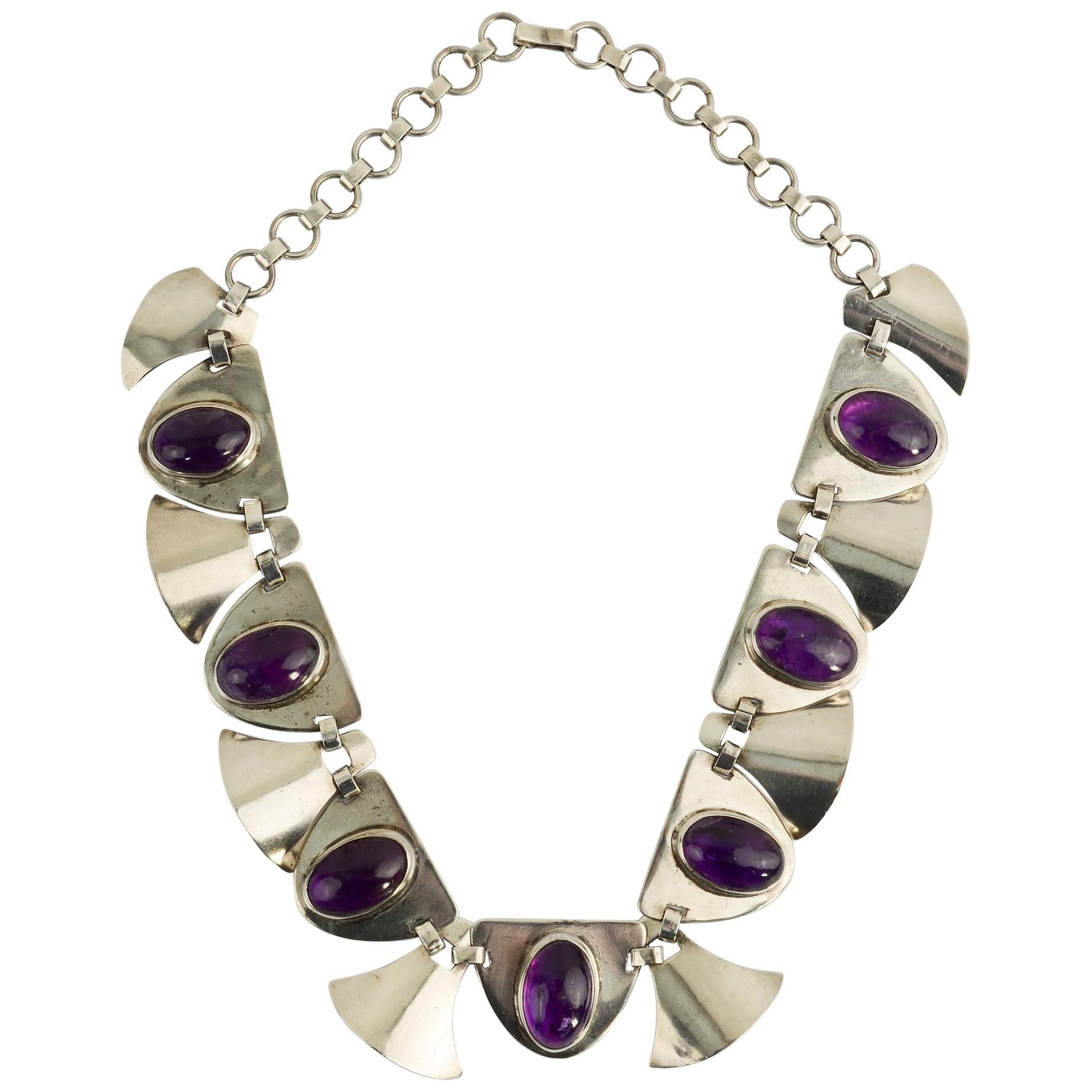Items Similar to Antique necklace. Gilt silver with amethysts. 19th c
Want more images or videos?
Request additional images or videos from the seller
1 of 11
Antique necklace. Gilt silver with amethysts. 19th c
About the Item
A beautiful antique necklace made in the second half of the 19th c. It is made of gilt silver and has 36 amethysts going from smaller to larger and then smaller again. The design of the necklace is simple but just so elegant. This is a piece that catches the eye any day. It is timeless and would fit a young person as well as an older one. Elegance purified.
The amethysts sizes varies from 17x10 mm to 9x7 mm.
- Metal:
- Stone:
- Stone Cut:
- Weight:38 g
- Dimensions:Width: 0.75 in (19 mm)Length: 16.93 in (430 mm)
- Place of Origin:
- Period:
- Date of Manufacture:19th c
- Condition:Wear consistent with age and use.
- Seller Location:Stockholm, SE
- Reference Number:1stDibs: LU2708220931512
About the Seller
5.0
Vetted Seller
These experienced sellers undergo a comprehensive evaluation by our team of in-house experts.
1stDibs seller since 2022
67 sales on 1stDibs
Typical response time: 1 hour
- ShippingRetrieving quote...Ships From: Stockholm, Sweden
- Return PolicyA return for this item may be initiated within 3 days of delivery.
More From This SellerView All
- Antique garnet necklace, 19th cLocated in Stockholm, SEGarnets were popular in the 19th c and maybe they will be sometime in the future.. But today not. That is why a piece like this can be bought at such a low price. The craftsmanship ...Category
Antique Late 19th Century Swedish Multi-Strand Necklaces
MaterialsGarnet
- Antique pair of silver ear rings. late 19th cLocated in Stockholm, SEA pair of silver earrings designed almost like Christmas tree decorations. They are hollow ad therefore hang light and easy on your ears. These are ear ri...Category
Antique Late 19th Century European Dangle Earrings
MaterialsSilver
- Swedish Silver Necklace Made Year 1954Located in Stockholm, SEThis silver necklace has a glossy surface. The small silver plates are shaped as perfect silver shells and they are connected together with silver rings. The necklace closes easily with a box clasp and it has also a safety chain. This is a piece of jewelry that can be worn with anything; a gala dress...Category
Vintage 1950s Swedish Link Necklaces
MaterialsSilver
- Silver Necklace Made in 1956, Atelier Borgila, Stockholm, SwedenBy Atelier BorgilaLocated in Stockholm, SEThis sterling silver necklace is adorned with 20 slightly brushed silver pendants shaped as shark teeth. It closes easily with a circle and a bar. The neck...Category
Vintage 1950s Swedish Link Necklaces
MaterialsSilver
- Antique earrings. Gilded silver and amethysts.Located in Stockholm, SEThese gilded silver earrings are adorned with cabochon cut amethysts. The framing of the amethysts is beautifully patterned and the earrings have so-called screw backs, like many of ...Category
Antique Late 19th Century Swedish Dangle Earrings
MaterialsAmethyst, Silver
- Antique brooch made of glass and gilt brass. Late 19th c.Located in Stockholm, SEA bright and happy brooch which also can be used as a pendant with a chain. The oval central part is made of glass and has a beautiful woman portrayed in profile, white on a purple b...Category
Antique Late 19th Century Swedish Brooches
MaterialsBrass
You May Also Like
- Antique Amethyst paste riviere necklace, sterling silver, 19th CenturyLocated in NEWARK, GBA tremendously good antique riviere necklace. Early Victorian era this beautiful antique riviere necklace borrows much of its design elements from the Georgian era, it showcases won...Category
Antique 19th Century British Early Victorian Beaded Necklaces
MaterialsSterling Silver
- Amethyst Diamond Silver Gold NecklaceLocated in Berlin, DEBelle Époque style. Front set with seven oval, graduating amethysts weighing total 29,14 carats and filigree arch links with 68 diamond roses weighing total circa 2,15 carats clarity...Category
Antique 1890s British Belle Époque Link Necklaces
MaterialsAmethyst, Diamond, 9k Gold, Silver
- Antique Early 19th Century Cut-Steel NecklaceLocated in Malmö, SECut steel jewelry was at the height of fashion from the mid 1700s well into the 19th century. Originated in the 1700s. Popular from the Georgian through the Victorian eras. To make cut steel, melted horseshoe nails were formed into tiny faceted beads. Those small steel gemstone-like studs were then riveted one-by-one onto a base plate. It was an English invention that quickly travelled throughout the world. Each stud could have up to 15 facets, and in general the finer and older the piece the more facets the studs will have. Improvements in candles meant that grand events and entertaining could take place at night. As diamonds are diamonds and not available for everyone, and everyone wanted to shine, the popularity grew. Cut-steel provided a stylish and popular new jewelry material that could be enjoyed by everyone at all levels of society. It grew beyond a simple imitation to an art in its own right. The manufacturing was complex and the workmanship that was required highly skilled. These were not mass produced objects. The studs were made from decarbonated cast steel, which was case-hardened, then the studs were faceted by cutting against a pewter wheel. Next were then polished with first fine emery and a hard brush, and then by hand with a special putty. Finally they were riveted onto pierced base plates which had to be drilled and cut by hand, too. The main place of cut steel production was Birmingham, England. And there, one manufacturer stood out from all the rest: Matthew Boulton. He had been born in 1728 into the industry — his father manufactured small metal products. But the younger Boulton had a special talent for marrying the latest technology with the latest fashion. He also was continually expanding — he even founded a mint. He wined and dined with dignitaries and advocated for his steel products. Fortuitously, he became quite close with the Russian ambassador to Catherine the Great. When the ambassador toured the mint, Boulton made sure to send the Empress some of his cut-steel necklaces. In 1759, Louis XV “encouraged” the nobility to donate their gold and gemstone jewelry to help fund the Seven Years War. The popularity of cut steel in France may in part have been due to these sumptuary laws which limited who could wear precious metals and diamonds. Either you complied with the law and gave up your family jewels to be melted down for the war chest...Category
Antique Early 19th Century English Early Victorian Link Necklaces
MaterialsSteel
- Ezequiel Tapia Silver Necklace with 14K Gold and AmethystLocated in Dallas, TXIntroducing our exquisite Silver Necklace with 14K Gold and Amethyst Stone, a true embodiment of elegance and sophistication. Crafted with precision and passion, this timeless piece ...Category
21st Century and Contemporary Mexican Modernist Link Necklaces
MaterialsAmethyst, 14k Gold, Silver
- Antique 1880 Garnet Necklace Silver Gilt Bohemian GarnetsLocated in Munich, BavariaThis delicate necklace is set with Bohemian garnets mounted in silver gilt. The necklace has been much loved and shows an old repair.Category
Antique 1880s Austrian Belle Époque Link Necklaces
MaterialsGarnet, Silver
- Fred Davis Silver and Amethyst NecklaceBy Frederick DavisLocated in Darnestown, MDFrederick Davis (1880 - 1961), while not the household name of William Spratling, actually preceded him in terms of bringing Mexican design to the fore. Davis worked in Mexico City d...Category
Vintage 1930s Mexican Modernist Link Necklaces
MaterialsAmethyst, Sterling Silver





